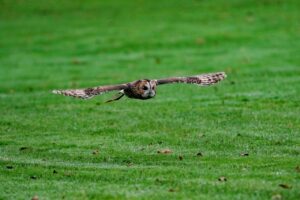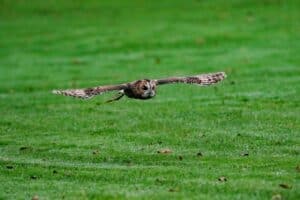The best hope for conservation in the US lies with private landowners
 21 April 2023
21 April 2023
Photo: Pixabay/USA-Reiseblogger
By Zack Vucurevich
While vocal constituents of preservationist groups are busy protesting policy decisions like President Joe Biden’s Willow Oil-Drilling Project in Alaska, the most under-represented stakeholder in conserving this nation’s wildlife remain unrecognized: private landowners.
Mainstream media champions the narrative that our nation’s wildlife and natural resources are here despite people’s best efforts to ruin everything and conservation would be lost without our state and federal agencies.
Meanwhile, private landowners — motivated by optimizing their land for hunting season — preserve and cultivate over 60% of our nation’s richest natural habitats (75% if you exclude Alaska).
When it comes to saving our planet, I wouldn’t bet on the alphabet soup of government agencies responsible for managing natural resources. Our best hope lies with landowners.
As a wildlife biologist and owner of a consulting firm specializing in wildlife habitat restoration on private lands, I work with many passionate conservationists, although you will never hear about them on the morning news. They will never win any awards for their contributions to habitat restoration, and quite frankly, many don’t even realize the breadth of their positive environmental impacts.
My clients are everyday citizens with average jobs who cultivate their private property so it will yield the best natural results for their recreation.
They are lawyers, accountants, truck drivers, brain surgeons, and even professional athletes. They are landowners, bird watchers, and wild game connoisseurs. They are non-traditionally trained botanists, foresters, and invasive-plant killing machines.
They all engage in intimate relationships with the native plant and animal communities in their region. They plant wildlife orchards of native trees and shrubs. They restore historical grasslands and prairies. They protect and create wetlands, and plant cover crops to prevent soil erosion.
Many of them are even designating portions of their farms to wildlife sanctuaries. These industrious Americans sacrifice their time and money to create the most productive wildlife oasis they can on their chunk of private property.
Yet, conservation activists don’t consider landowners when discussing environmental stewardship, because unlike their conservationist counterparts, my clients are motivated not by the moral or ethical practice of conservation but by the quality of the wildlife that comes out of proper land management.
For example, many of my clients’ environmental efforts go towards having the opportunity to hunt bigger game. While the public is generally okay with hunting, they’re willing to discredit science-backed natural resource management practices when the intention is to produce a “trophy” animal.
Newsflash: it takes a healthy, intentionally managed chunk of ground to produce a trophy animal. It is this very incentive that drives many of my best clients to cultivate the ideal habitats for wildlife, and their sport even contributes to the health of the ecosystem.
Managing properties for deer hunting yields exceptionally beneficial results. The white-tailed deer, in particular, is an edge species, meaning they will gravitate towards areas where two or more habitat types meet forming an “edge.”

In its simplest form, the more different habitat types I can squeeze onto a property, the better it will be for the deer. This is great news for specialist species such as songbirds and amphibians who require more specific habitat types to meet their ecological needs, as diversifying the landscape for deer creates pockets of unique habitats formerly absent from the region.
When a property owner begins managing their property for healthier deer, they are indirectly responsible for creating a more diverse and resilient ecosystem capable of sustaining a plethora of non-game species to admire.
This motivation benefits the land as well. A soybean field is essentially a biological desert from when the crops are harvested in the fall until the field is replanted and actively growing the following spring. But if I can convince the landowner to convert portions of his agricultural fields into native grasslands, the local deer herd will suddenly have food and cover across an otherwise barren landscape.
Not only will the deer benefit, but the non-game species will as well. Species such as the Northern Bobwhite, mole kingsnake, and Golden-winged warbler rely on these plant communities to meet their habitat requirements. If a property does not possess early successional plant communities, these specialist species of wildlife will not occur either.
The incredible amount of time, effort, and finances my clients invest into their properties are not anomalies. For every landowner I work with, there are thousands more trying to achieve the same goal: conserving wildlife.
In the 1930s, the “father of wildlife conservation,” Aldo Leopold, described his idea of responsible land stewardship as a land ethic: “A land ethic changes the role of Homo sapiens from conqueror of the land-community to plain member and citizen of it. It implies respect for his fellow members, and also respect for the community as such.”
In an era when the media wants you to believe the oceans will boil tomorrow and Uncle Sam is your only savior, rest assured that at least 75% of our contiguous landmass is being responsibly managed.
I can’t say the same for the 25% that is state and federally owned. Nobody has more to gain (or lose) from environmental calamity than the men and women who have invested their blood, sweat, and savings into their own soil.
We’re wasting our time chaining ourselves to trees or throwing tomato soup on priceless museum artifacts in the name of #ClimateChange. If we really want to have a positive environmental impact, we need to focus our efforts on making conservation project funding opportunities more easily accessible to the men and women managing the bulk of our land and wildlife.
Zack Vucurevich is a wildlife biologist and owner of Whetstone Habitat, LLC, a wildlife habitat restoration and consulting company. He is a freelance writer and contributor to Young Voices. His work focuses on conservation, hunting culture, and various other outdoor-related topics.
The post The best hope for conservation in the US lies with private landowners appeared first on Sustainability Times.
